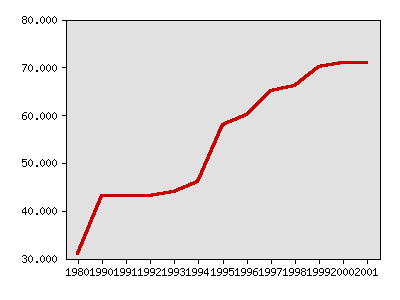What were things like in 2002?
The following idicator summary is from the 2002 Minnesota Milestones and does not neccessarily reflect the current data trends.Indicator : Transportation for people with disabilities
Rationale: Transportation is a basic service that allows people with disabilities to participate more fully in community life.
About this indicator: In 2001, 71 of Minnesota's 87 counties offered countywide public transportation serving those with disabilities, up from 43 in 1990.
Lack of transportation bars people with disabilities from many aspects of community life, including employment. Despite federal laws that require equal access to public facilities and services, public transportation is not consistently available statewide. All public transit providers obtain their funding from the state, which requires that access to transit be provided to the public, including seniors and those with disabilities. However, service is not guaranteed to every resident. Nine counties that do not provide countywide service do offer limited service in one or more communities. Seven of the state's 87 counties provided no service in 2001.
Number of counties with countywide public transportation serving people with disabilities

| Year | Data |
|---|---|
| Number of counties with countywide public transportation serving people with disabilities, Minnesota Department of Transportation | |
| 1980 | 31 |
| 1990 | 43 |
| 1991 | 43 |
| 1992 | 43 |
| 1993 | 44 |
| 1994 | 46 |
| 1995 | 58 |
| 1996 | 60 |
| 1997 | 65 |
| 1998 | 66 |
| 1999 | 70 |
| 2000 | 71 |
| 2001 | 71 |
Things to think about: As the state's population grows older, transportation needs for people with disabilities will likely increase. An expected relocation of the population into rural communities in the future may place additional demands on transportation systems in those areas, as people choose to rely less on their own skills and abilities if alternative transportation exists.
Technical notes: Indicator data is based on the number of counties in which the Minnesota Department of Transportation provides grants to support countywide transit services.
Sources:Minnesota Department of Transportation, Office of Transit, 2001 Minnesota Transit Report, www.dot.state.mn.us/transit/treport/
Minnesota Planning, Perspectives Report: Implications of rural Minnesota's changing demographics http://www.mnplan.state.mn.us/pdf/2000/rural_01.pdf
Related 2002 Milestones indicator:
Other related indicators:
- Requests for transportation in the Twin Cities area that Metro Mobility cannot accommodate (Metropolitan Council, www.metrocouncil.org)
- People with disabilities who are on waiting lists for community services (Minnesota Department of Human Services www.dhs.state.mn.us)
- School children with disabilities who participate daily in general education classes (Minnesota Department of Children, Families & Learning cfl.state.mn.us)
Local data:





